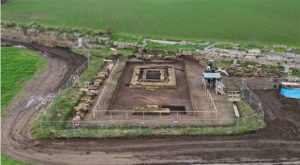Discovered in the 2,600-year-old City of Poseidonia Paestum are Two Magnificent Greek Temples

Archaeologists have unearthed two “exceptional” temples in the historic ancient city of Poseidonia Paestum, a settlement in Magna Graecia on the southern coast of Italy. Constructed in the Doric style, the temples have been unearthed in the western sector of this important ancient settlement, near the city walls and situated just a short distance from the sea.
Well-Preserved Architectural Remains at Paestum
Paestum, originally Poseidonia but re-named by the Romans, is situated on the western coast of southern Italy in the province of Salerno, Campania. It held significance as a vital settlement in Magna Graecia, a term the Romans used for the coastal regions of southern Italy populated by Greek speakers since the 8th century BC.
Founded around 600 BC by Sybaris settlers, Poseidonia flourished for two centuries before falling under the control of the Lucanians, an Italic tribe, around 400 BC. Later, in 273 BC, the Romans conquered the city, renaming it Paestum.

Just How Rich Were the Inhabitants of Magna Graecia Really?
Two Warrior Helmets Unearthed At Greek Temple In Velia, Italy
5th century Doric temple ruins recently found at Paestrum. (Italian Ministry of Culture)
Continuity of Worship Across Empires
Dating back to the early 5th century BC, one of the recently discovered temples at the Paestum archaeological site includes remarkably well-preserved architectural remnants, particularly the stylobate—a stepped platform supporting the columns that upheld the temple roof.
The stylobate, measuring 11.5 x 7.6 meters (37.5×24.6 feet), exhibits distinct features, including the four-sided peristatic columns encircling the inner sanctuary referred to as the ‘cella’. Traditionally, the cella served as a sacred space housing a cult image or statue representing the specific deity venerated in the temple.
“These exceptional discoveries, which add new fundamental pieces to the reconstruction of the archaic history of the Magno-Greek colony of Poseidonia, document the multiple construction phases of a sanctuary located in a liminal area, near the coast from which the settlers themselves had come a few decades earlier, and built in the archaic era, even before the city had a defensive circuit”, explained the Director of the Archaeological Park of Paestum and Velia, Tiziana D’Angelo in a press release.

Poseidon: Greek God of the Sea Who Created the Minotaur
The Steam-Powered Pigeon of Archytas – The Flying Machine of Antiquity
One of the two newly found Greek Doric temples at the historic Paestum site. (Italian Ministry of Culture)
Behind the temple, the investigation unearthed the remnants of the internal vestment of the city walls, revealing a collapse that had impacted the temple, resulting in partial destruction. Below this collapsed structure, archaeologists identified the layout of a beaten road running parallel to the temple, displaying a different orientation than the surrounding walls. This finding indicates that by the end of the 6th century BC, when the oldest temple was built, the city of Poseidonia did not yet have defensive walls.
During a period characterized by substantial growth and monumentalization of the polis, the settlers of Poseidonia strategically erected a sanctuary in a prominent location, serving as a protective focal point for the urban space and visible from the sea.
The significance of this sacred space is underscored by the enduring and continuous use for over five centuries. It points to the fundamental continuity of worship spanning the Greek-Lucan and Roman periods, attesting to the enduring cultural and religious importance of Poseidonia.

The Paestum archaeological site is extensive, with much of the more modern parts of the ancient city already uncovered. (lamio/Adobe Stock)
Paestum: A Vitally Significant Settlement in Magna Graecia
The archaeological site of Paestum gained renown for its exceptional preservation of three ancient Greek temples built between approximately 550 and 450 BC. They were constructed in the Doric order (an early classical architectural style) and dedicated to the Olympians Hera, Athena, and Poseidon.
Showcasing the cultural and religious practices of the ancient inhabitants of Poseidonia, the site’s temples are an important draw for visitors even today.
“The recent discoveries confirm there is still a lot to do in Paestum in terms of excavations, research and also in terms of valorization,” Gennaro Sangiuliano, Italy’s culture minister, said in the release.
The Ministry of Culture explains that this latest archaeological find holds significance in broadening our understanding of the ancient settlement’s dynamics and the evolution of Doric architecture in Poseidonia and Magna Graecia as a whole, in particular understanding Paestum’s layout in this context, reports Arkeonews.
D’Angelo described these findings as crucial evidence, emphasizing their importance in reconstructing the ancient history of Poseidonia.
“The new Pestani excavations are yet another demonstration of how study and research are pillars in the management of cultural heritage and fundamental tools of the protection and enhancement functions that the State is called upon to carry out, in a perspective that is as widely synergistic between the various professionals involved in various capacities in archaeological investigations”, concluded the Director General of Museums, Massimo Osanna